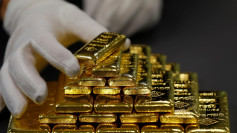The US dollar struggled on Tuesday, following a decline in American manufacturing activity last month, which indicated a slowing economy and overshadowed renewed inflation concerns in the wake of OPEC+'s unexpected output reduction. The Institute for Supply Management (ISM) reported on Monday that manufacturing activity in March had dropped to its lowest level in almost three years, with all subcomponents of its manufacturing PMI falling below the 50 threshold for the first time since 2009.
This development sent the greenback lower across the board, mirroring a drop in US Treasury yields, as investors adjusted their expectations regarding the duration of restrictive interest rates. The British pound, as well as the Australian and New Zealand dollars, subsequently climbed to multi-week highs against the weakening dollar in early Asian trading on Tuesday.
Sterling reached its highest level since late January, at $1.2425, extending its previous session's 0.7% increase. The kiwi gained 0.2% to $0.6310, its highest since mid-February, while the US dollar index slipped to 102.02, having fallen over 0.5% on Monday.
Wells Fargo economists commented on the ISM manufacturing report for March, stating, "The closest thing we get to good news in (the) report is that the slowing in the factory sector is pushing prices lower and supply chains are continuing to heal, benefiting from the slack." They added that the other trends in the report typically foreshadow an economic recession.
Market expectations now indicate that the Federal Reserve will start cutting rates from September through the end of the year, with rates projected to be just above 4.3% by December. Meanwhile, the two-year Treasury yield fell nearly 10 basis points on Monday, standing at 3.9841%.
The weak US economic data eclipsed renewed inflation fears after OPEC+ shocked markets by announcing plans to cut additional production, which led to a 6% surge in oil benchmarks on Monday.
In other developments, the Australian dollar steadied after reaching a one-month high of $0.67935 earlier in the session, as the Reserve Bank of Australia (RBA) prepared for a crucial monetary policy decision on Tuesday. A poll of analysts suggested that the RBA would halt policy tightening, but a significant minority still anticipated a rate hike. Last week, data revealed that Australian inflation had slowed to an eight-month low in February, partly due to a sharp decrease in holiday travel and accommodation prices.






